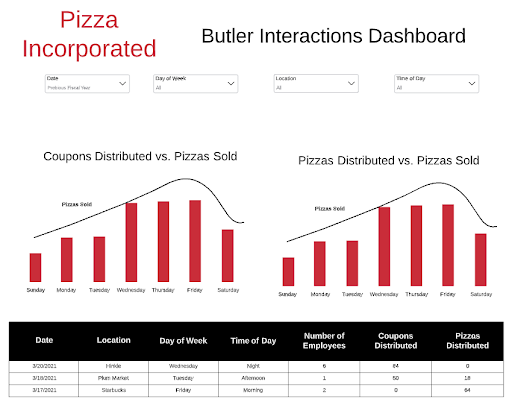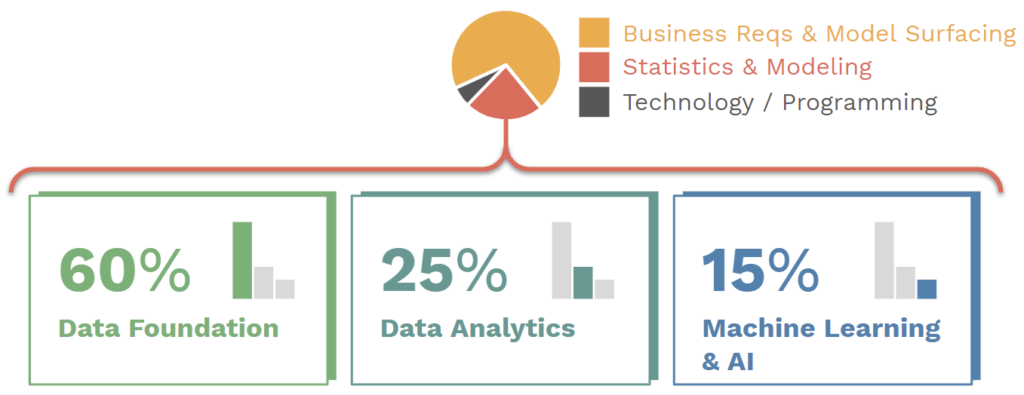Co-authored by Joshua Fleischer and Sarah Young.
As businesses increase their utilization of data and the insights they gather from it, universities are realizing the need to prepare students for today’s data-driven climate. Professors toe an interesting line. In a semester’s time, they need to provide a basic academic background for data modeling and analytics while also giving the context for solving business problems. In March of 2021 at Butler University, three of Atrium’s consultants spoke with Professor Jason Davidson’s Data Analysis and Business Modeling class about business strategy, data visualization, and machine learning. Here’s what the students learned.
Business Analytics Starts With Business
The goal with Professor Davidson’s class was to raise awareness to the fact that all the data in the world will not improve business processes if it doesn’t provide the insights the end users need. While data modeling and analytics insights are great, we cannot get very far without knowing why we are building them.
“Sarah’s discussion of constantly involving the customer was one that makes sense, but something I don’t think I was particularly sure about regarding business analytics before the presentation,” said Jack Jankowski, a student in the class. “Constant feedback and discussion with the client is essential to building anything, and data systems are most certainly no different.”
As Jack points out, constant feedback and discussion becomes essential to building anything: systems, Analytics insights, and data models.

Data Visualization
Coming into the presentation, the Atrium team was aware that the students in Professor Davidson’s class would soon utilize Power BI to build dashboards for a class project. The data visualization portion of the presentation was split into two parts. The first part centered on connecting analytics to the business, including utilizing personas and key performance indicators to drive business intelligence. The latter half of the session was focused on dashboarding best practices. The team highlighted user experience, commonly used design patterns, and even spent time building a wireframe with input from the students.
“Prior to the (Atrium) presentation, I did not understand the amount of work that goes into creating a successful model,” said Samantha Coleman, a student in the class. “I used to believe it was just compiling the data and organizing aesthetic graphs and tables to display the data. But after the presentation, I understand that to be successful in business analytics, I must consider many more aspects like the collection of the data, analyzing to see if it is ‘good’ data, creating a model for the end user, etc.”
Machine Learning
The intended takeaway from the machine learning section of this lecture was that models fail often. But more importantly, there are clear ways to avoid the path to failure.
The first step is to set proper expectations with regards to what makes a successful model. It is a common misconception for many individuals new to the field to assume a Data Scientist’s time is primarily spent creating models and algorithms. A good mixture for successful model creation and execution is focused on the business and the problem to be solved — focusing just on the statistics and technology is a path toward model failure. Furthermore, the actual creation of the model is only a small portion of the overall statistics and modeling-focused work.
Another vital element of creating successful machine-learning models is iteration. It is unlikely that one will ever create a successful model without returning back to a prior phase in development. It’s common to iterate multiple times before a model is ready to be released to production or consumed by the end user. Even then, model iteration doesn’t stop as data in business is rarely static. Frequent reassessment and maintenance of models is required to ensure their continued success.
“I found Josh’s perspective on the iterative nature of machine learning to be fascinating. I think science fiction has given us this idea that ML is a switch that gets flipped, one moment it’s all human work and the next the computer has solved every problem ever,” said Jack.
Tying It All Together
After talking to the class about business knowledge, data analytics, and machine learning as individual topics, Atrium’s consultants drove home the point that adding business value is not exclusive to any of those elements, but comes from bringing them all together. With respect to adding value, Professor Davidson commented on the value that the presentation brought to his classroom:
“First, I would like to start by once again thanking the team at Atrium for presenting to my class, Data Analytics and Business Modeling. The presentation was a wonderful mix of applied technology practices and soft skills. The class of 62 students enjoyed learning about the techniques Atrium uses to meet their client’s needs. They also took great interest in learning tips and best practices in transitioning from the classroom to a professional environment. Overall, it was an invaluable experience and we would like to welcome the Atrium team back anytime they are available.”
College grad or about to be? Interested in a career in consulting? Learn more about our Luminate program.













